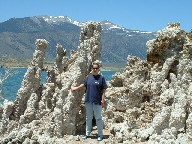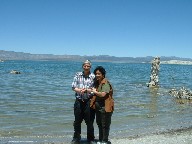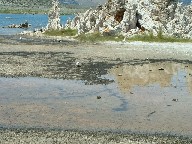Yosemite National Park (6/29/03 - 7/1/03)
7/13/03
Summary: Yosemite was a lot of fun and
it was my first recent exposure to "nature" in quite some time. The
visit included everything from snow in June, to beautiful waterfalls
and interesting hikes filled with a taste (not literally) of the local
flora and fauna.
Danger, Will Robinson! Danger!
Excruciatingly boring details below!
The first day of our trip mostly consisted of the drive from
Sunnyvale to Yosemite (pretty boring), with a stop near the Tioga Pass
(the highest elevation road in California -- if I remember correctly, almost 10,000 feet above sea level)
to play in the snow.... the cold snow and fresh mountain air was a
great contrast to the intense heat of Sunnyvale.
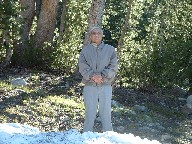
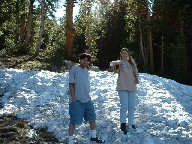
On the second day of our trip we did a little hike to Bridalveil
Falls where we took the pictures shown below. The falls are
magnificent, but since the hike to them is really easy (paved road and
a very short distance), they were very crowded and less peaceful than
what I would've liked. We also visited the Lower Yosemite Falls, which
were nice but also quite crowded.
Despite the numerous danger signs ("fatalities occur here every year"),
people let their kids play on slippery rocks right in the stream at the
bottom of the waterfall. Where is natural selection when you need it?!
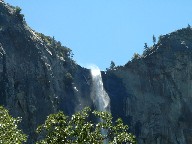
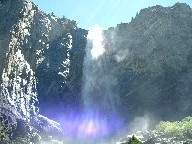
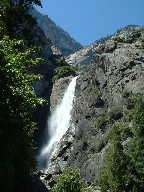
We also had the chance to do a little hike to Mirror Lake using a horse
trail (big mistake -- tons of horse excrement, and associated smells
detracted from the otherwise pleasant hike). Neat thing about Mirror
Lake is that the surrounding mountains are beautifully reflected in the
still waters of the lake. The
original name of the lake in the language of native Indian tribes was,
quite appropriately, "Still waters". From Mirror Lake you also get a
good view of the Half Dome which the natives called "Woman turned into
stone". It's really too bad that the conqueror's instinct of the white
man required renaming of each and every place in America... I think I
prefer the old placenames.
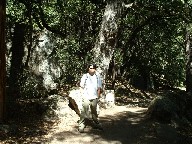
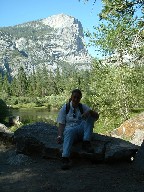
The Tulomne meadows are quite pretty too.. they had this creek (or
brook) or was it a river? In any case, it was nice, and there were also
deer that Daria got to see, which made her happy... though she can be
somewhat greedy for that sort of stuff and complained that we "hadn't
seen a single bear or mountain lion" -- as if all of the squirrels,
rabbits and deer weren't enough! The
best time for deer watching turned out to be after 5pm when they come
out to the meadows in herds for grazing and drinking from creeks
(brooks?), lovely graceful creatures that they are. Some people don't
care as much for deer beauty thought; in midwestern states deer are
considered pests, as they often raid fields and gardens of peaceful
citizens. I heard that the Bamby movie was a disaster for farmers
because they could no longer shoot intruding deer without causing
hysterics in their children: "Daddy killed Bamby!"
Anyhow, here are some pics of Tulomne
meadows....
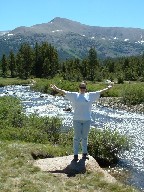
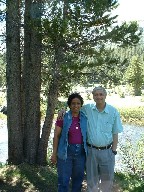
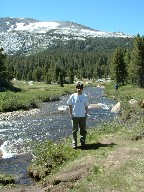
We also got to do some kayaking at Gull Lake, which was pretty close to
June Lake where we at the Heidelberg Inn during our visit. Supposedly a
lot of movie stars stayed at that Inn in the early part of the century
and the place was charming and cozy. Quite a few movies were filmed at
Heidelberg Inn as well, since the inn itself and the area around it
carries a close resemblance to Swiss Alps, especially when buried in
snow in winter time.
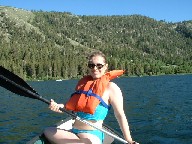
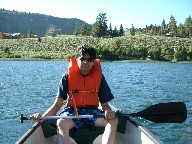
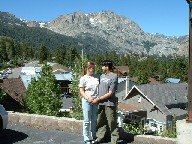
Another interesting place that we visited near Yosemite was Mono Lake.
The lake is really salty and alkaline (much more so than the ocean, and
I'm sure Daria will add the exact values in her blog) with these
interesting rock formations called Tufas. Daria's input: Yes, the lake is 2.5
times saltier than the ocean, owing to the lack of any waterways out of
the lake. The lake is refilled from the streams running down the
surrounding mountains during snow-melting season, but the only means of
lowering the water level is evaporation. Therefore, all salts and
sediments brought into the lake stay there forever, making the water
saltier and more alkaline overtime. Now it even feels soapy to the
touch! The high salt content of the water makes it impossible for any
fish to live there; the only wildlife in the waters of the lake is
shrimp.
There are also a lot of flies
that subsist on alkaline algae and ignore people for the most part. In
the picture below, the whole black area is just flies, and whenever you
walked toward it (or a gull ran through the area), the black would
spread, much like Moses parting the Red Sea. Pretty interesting, but
still a bit nasty, especially when combined with the salty smell...
however Daria really liked it and wasn't grossed out (go figure). And why would I be grossed out? For
your information, the native tribes in the Mono lake area gathered the
flies for food and for trading with other Yosemite peoples. The
original name of the lake, which later on got shortened to "Mono",
meant "fly-eaters". Supposedly the algae flies, when dried out, make
for a wonderful crispy snack. Yucky :-)
Pretty-looking tufas (see pictures below) get formed when freshwater
springs from the bottom of the lake propel their calcuim-rich water
through alkaline waters of the lake. Their chemical reaction creates
calcium carbonate, the building material of tufas. Varying water
streams shape tufas into all sorts of fantasmagoric formations that
look a lot like coral reefs - or like that stone for scraping the soles
of your feet, if you prefer down-to-earth analogies.
